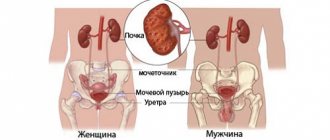What does it mean if potassium in the blood of an adult is elevated?
Increased potassium in the blood is referred to in medicine as hyperkalemia. The potassium value in a laboratory analysis for hyperkalemia should be 5.2 mmol/l or more. A severe form of this condition requires emergency medical care for a person. Because it poses a danger to the proper functioning of the cardiovascular system.
The normal level of potassium in blood serum for an adult is from 3.4 to 5.2 mmol/l.
Up to 98% of the macroelement in the human body is concentrated inside cells, the remaining part (2%) enters the extracellular fluid and bloodstream. Maintaining the membrane potential of cells is possible only with a balanced content of potassium and sodium ions.
The need for potassium, as one of the most important macroelements, lies in its role in the following processes:
- maintaining the potassium-sodium pump to ensure the transmembrane potential of cells;
- creation and maintenance of homeostasis;
- transmission of nerve impulses and action potentials in nerve cells.
Therefore, any deviation of the indicator from the norm, up or down, affects the above processes.
An increased level of potassium in the blood indicates a violation of the process of its removal from the body. The macroelement is excreted in the urine after filtration and reabsorption in the kidneys, sweat glands and along with feces.
Read further: Table of potassium levels in the blood for women and men
Pathological causes of increased potassium
Let's take a closer look at what pathologies are indicated by increased potassium in the blood.
Kidney failure
In acute or chronic forms of renal failure, potassium ceases to be fully excreted from the body and begins to be deposited. In this case, the active parenchymal tissue of the kidneys is destroyed and replaced by connective tissue. Diseases leading to kidney failure: pyelonephritis, urolithiasis (kidney stones) or glomerulonephritis. Less commonly develops against the background of diabetes mellitus or atherosclerosis. The treatment regimen is drawn up exclusively by the attending physician and is aimed at eliminating the cause that provoked renal failure.
Adrenal glands
Chronic insufficiency of the adrenal cortex leads to a lack of mineralcorticoids, which are directly involved in the regulation of potassium levels. The incidence of the pathology is 1 case per 100 thousand people. It does not matter the gender or age of the patient. Therapy for this condition involves taking hormonal medications, the duration and dosage of which is determined by the doctor.
Aldosterone is responsible for the excretion of the macroelement in question, so its deficiency leads to disruption of this process.
Tissue damage
Another reason for high potassium levels in the blood is tissue damage. Since the main part of potassium (up to 98%) is concentrated in the cells, if their integrity is violated, a sharp jump in the indicator is noted.
Concomitant pathologies, for example, diabetes mellitus or infections, can cause the indicator to deviate from the norm to a greater extent.
Other reasons
A blood test to determine macronutrient levels is taken on an empty stomach. The minimum interval from the last meal for adults is 12 hours. If a person has consumed potassium-rich foods for a long time, the test result may be higher than normal. Foods that contain large amounts of macronutrients: bananas, grapefruits, melons, potatoes and tomatoes.
It should be emphasized that there is no need to completely abandon the above products on the eve of the analysis. It is only important not to consume them in large quantities.
Medicines that increase potassium levels:
- non-steroidal anti-inflammatory drugs;
- beta blockers;
- diuretics with the ability to retain potassium in the body;
- sodium heparin;
- histamine;
- mannitol
Their use should be reported to a laboratory staff member. When deciphering the result, the doctor will take into account the effect of these drugs. And if necessary, he will prescribe a repeat test after completing treatment with these medications.
Functions and norm
Potassium compounds are responsible for the normal condition of soft tissues, which make up muscles, kidneys, blood vessels, brain cells, capillaries and other organs. In addition, this important microelement performs the following functions:
- maintains intracellular osmotic pressure;
- regulates acid-base levels;
- transmits nervous stimulation to muscle tissue and contracts them;
- normalizes and maintains water-salt balance and intracellular fluid volume.
The norm of potassium in urine and blood per day, respectively:
- in newborns up to 2 months of life it is 0-25 and 4.7-7.5 mmol;
- in children from 6 weeks to 12 months - 15-40 and 4-6.2 mmol;
- in children from one year to 15 years - 20-60 and 3.6-5.9 mmol;
- in adults, normal levels are 35-80 and from 3.8 to 5 mmol.
Why is high potassium in the blood dangerous?
An increased level of potassium in the blood causes depolarization of the cytoplasmic membrane of cells. Since the equilibrium potential of the macroelement decreases. Depolarization in turn leads to increased permeability of sodium channels. In this case, an action potential does not occur because the depolarization is insignificant.
A critically high concentration of potassium can cause inactivation of sodium channels, which leads to their complete opening. Patients experience disruption of the nervous, muscular and cardiac systems, as well as disruptions in the gastrointestinal tract. Physical activity promotes the release of potassium ions from muscles into the blood serum.
The person is in serious danger of shock, respiratory failure or abnormal heart rhythm. There are disruptions in the transmission of nerve impulses in muscle tissue and between neurons. What can cause the loss of the ability to contract the heart muscle.
What is pseudohyperkalemia?
Pseudohyperkalemia develops in people with pathologies of the circulatory system.
This condition occurs after taking blood from a patient for analysis. At the same time, potassium enters the extracellular space and, thus, its level increases at the general norm. The reason for this condition is the formation of microthrombi, violation of the rules for taking blood for analysis, and the development of hemolysis. Pseudohyperkalemia develops in people with concomitant diseases of the circulatory system.
When examining potassium, it is necessary to determine sodium in the urine, since these two ions are related to each other, and a change in one indicator will be reflected in the other.
The symptoms of this condition will not correspond to the clinical picture of true hyperkalemia, since there are no reasons for its occurrence. To exclude an increase in potassium in the blood, it is necessary to determine its concentration in plasma and serum. In the first case, the ion level will correspond to normal values, and in the second, the level will be higher by 0.2-0.4 mmol/l.
Symptoms of hyperkalemia
Symptoms indicating an increase in potassium in the human body:
- convulsions;
- abdominal pain;
- reduction in heart rate to 60 per minute or less;
- muscle weakness;
- fast fatiguability.
A critical state of hyperkalemia is accompanied by disruption of the heart muscle, which can be detected on an ECG. Despite the fact that a direct relationship between ECG changes and potassium levels has not been established, this diagnostic method should not be excluded when examining a patient.
How to lower potassium in the blood quickly and effectively
Therapy of hyperkalemia involves the use of sodium zirconium cyclosilicate. The Committee for Medicinal Products for Human Use of the European Medicines Agency has approved its effectiveness and efficiency in diabetes mellitus, renal failure and heart disease. According to the results of a pilot study, 98% of patients were successfully treated with this drug. At the same time, the duration of remission lasted up to 12 months.
The active removal of potassium from the body is facilitated by stimulation of the intestines when creating a positive osmotic gradient. To do this, the doctor prescribes gastrointestinal dialysis to the patient with the following solutions:
- magnesium sulfate;
- oil emulsion;
- ion exchange resins;
- various sorbents.
A single procedure is not enough for effective treatment. The effectiveness of therapy is evidenced by a decrease in the severity of symptoms of hyperkalemia and a decrease in the concentration of ions in the blood serum.
It should be noted that in order to normalize the indicator, it is necessary to identify the reason for its increase. Treatment of the pathology will lead to an improvement in the patient’s condition and restoration of the normal balance of potassium ions in human cells and blood serum.
Causes of reduced levels in blood and urine
A condition characterized by a reduced level of trace element K in the blood is called hypokalemia. This pathology occurs for a number of the following reasons:
- eating foods low in potassium;
- loss of the element as a result of severe diarrhea, vomiting;
- potassium loss in diabetes mellitus, Conn's syndrome, Cushing's disease, Bartter's syndrome;
- with improper treatment of hyperglycemia;
- with reduced glucose levels;
- as a result of testosterone therapy;
- for ailments characterized by increased sodium levels.
The potassium content in urine decreases for the following reasons:
- frequent loose stools;
- acute kidney dysfunction;
- chronic pyelonephritis;
- disruption of nutrient absorption processes in the small intestine;
- Addison's disease;
- glomerulonephritis;
- shift in acid-base balance.
Symptoms
When the level of potassium in the body is low, the following symptoms may occur:
- nausea;
- loss of appetite;
- increased irritability;
- general weakness;
- gagging;
- muscle soreness;
- thirst;
- state of indifference, psychosis;
- cardiopalmus.
How to reduce potassium in the blood at home
First of all, you should avoid all medications and dietary supplements containing potassium. Eliminate or minimize macronutrient-rich foods. Treatment with folk remedies, including herbs: alfalfa, dandelion, horsetail and nettle, is unacceptable.
Taking laxatives and diuretics promotes the active excretion of potassium ions. Combined use with ion exchange resins can significantly increase the efficiency of excretion. Since oral administration or rectal administration of resins allows you to retain the macroelement in the large intestine. This increases its concentration in feces and is excreted from the body.
Important: severe cases of hyperkalemia require treatment exclusively in a hospital hospital setting. The patient may require IVs to cleanse the body.
A person with hyperkalemia should give up bad habits (alcohol and smoking). It is advisable to increase the amount of daily physical activity to half an hour.
Coffee and strong black tea can be replaced with green tea and chamomile infusion. Drinking enough water per day (minimum 1.5 liters) promotes the natural excretion of macronutrients.
Pregnant women are strictly prohibited from self-medicating. Since correction of the indicator value should be carried out exclusively under the supervision of a specialist. Neglecting this rule can have a negative impact on the intrauterine development of the baby and pregnancy in general.











